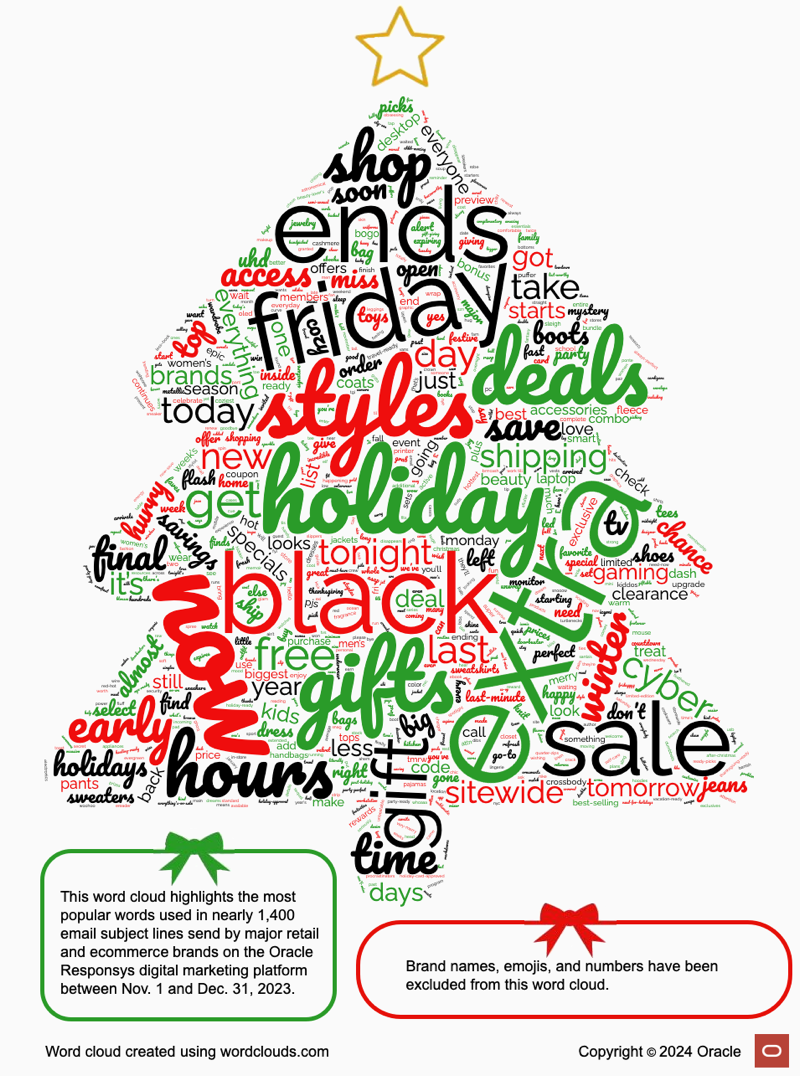As you plan your holiday promotional email campaigns, you’ll certainly want to draft subject lines for your intended campaigns. In fact, you’ll want to write multiple subject lines for each one so you can do some A/B testing. To get you inspired, we created this holiday subject line word cloud based on nearly 1,400 subject lines sent by major retail and ecommerce brands on the Oracle Responsys digital marketing platform between Nov. 1 and Dec. 31, 2023.
If you’re unfamiliar with word clouds, the more frequently a word is used, the larger it appears in the word cloud. So, for instance, some of the most commonly used words in ours include: extra, black, Friday, holiday, ends, gifts, now, sale, styles, and deals. Of the more than 1,250 unique words used across those nearly 1,400 subject lines, 802 words are included in the word cloud below, which means the 450 least frequently used words are not included.

While that’s interesting, let’s take a deeper dive into what this word cloud reveals about email subject line writing during the holidays and how that can help you write better subject lines.
Themes in Word Choices
First, many of the most popular words fall into six categories. Let’s talk about each of them and share the subject line words that fall into each bucket.
Urgency. Always a strong lever during any seasonal buying occasion, urgency tells subscribers they need to act quickly to take advantage of an offer or ensure a product is available. The words that fall into this category include: ends, now, hours, early, time, day, final, last, tonight, soon, tomorrow, and chance.
Occasion. Working along with urgency, occasion typically puts further restrictions on when action is needed. Unsurprisingly, it’s clear that Black Friday and Cyber Monday were major occasions that drove action. What may surprise some is just how little Thanksgiving and Christmas are referenced in subject lines.
Savings. Shoppers are always looking to stretch their holiday budgets, so the holiday season is very promotional most years, as it’s expected to be this year. The words in this category include: extra, sale, deals, free, save, savings, specials, and clearance.
Abundance. More than other seasonal buying occasions, the holiday season is a huge celebration that’s about generosity—and, if we’re being honest, about excess. It’s also often about no restrictions when it comes to discounts or deals. Some of the words in this category include: extra, free, sitewide, big, everything, and everyone.
Status. These words help convey the excitement of the holiday season, while also supporting urgency messaging. The words that fall into this category include: new, top, specials, perfect, and exclusive.
Sentiment. As much as shoppers are looking for value, they’re also looking to connect emotionally with what they’re buying and who they’re buying it for. The words in this category include: cozy, happy, and festive. During the past two holiday seasons, B2C brands have been using sentiment-oriented words considerably less than they did in 2020 and 2021, when words like cozy, comfort, love, warm, and fun were more popular.
All of those categories and words may not be appropriate for your organization, but look at each category and consider which words might be the most relevant to your audience. Then ask yourself how your brand might say it or put its own spin on it. Make a list of words or phrases to refer back to when it’s time to write!
What’s Missing from Our Word Cloud
Second, let’s recognize some important subject line components that are excluded from our word cloud, but should almost assuredly be present in your subject lines.
Numbers. Whether it’s a percentage-off or dollar savings, numbers are critical to conveying value.
Punctuation. So many exclamation marks!!! And how many question marks are too many questions marks? Who knows, but both are long-standing subject line elements, along with dashes (-), hyphens (– and —), colons (:), ampersands (&), bars (|), and other symbols.
Emoji. Another powerful visual element, emoji are best used at the beginning and end of subject lines, and as a divider between ideas. According to Oracle Digital Experience Agency research, 24% of retailers’ holiday promotional emails included one or more emojis in their subject lines. Wrapped gift (🎁) and sparkles (✨) were the most commonly used emojis. Thematically, emojis that deal with time were also popular, including hourglass not done (⏳), alarm clock (⏰), and timer clock (⏲️).
Discount codes. These are routinely used in subject lines, but were excluded since they wouldn’t be insightful.
Personalization. Best reserved for highly personalized emails and triggered campaigns, adding personalization to a subject line can be effective. Admittedly, first-name merge tags and other personalization tend to be pretty rare in holiday subject lines.
Sender’s name. Many retailers used their own brand names in their subject lines, including as part of the name of their loyalty program or sale name.
Brand names. In addition to promoting general sales and category-specific sales, plenty of retailers promoted their most popular product brands. You should, too.
We excluded the names of both senders and brands to protect the anonymity of our customers, as well as in recognition that your most popular brands may be different.
Evolve Your Strategy over the Season
Third, think about how and when your vocabulary might need to shift throughout the holiday season. You probably want to express a variety of sentiments or levels of urgency at different points—as well as for different audiences. Identify those points in time and audience segments, and then note the change in tone and messaging in your content calendar.
For example, generally speaking, we find that abundance and status themes are the most prevalent in October, the occasion and savings themes most popular in November, and urgency most popular in December.
Analyze Your Own Subject Line Word Choices
And fourth, look at your own subject lines from last November and December. Consider using wordclouds.com or another word cloud generator to see which words you used the most and what word themes were the most prevalent.
Then compare that to what we found. Doing this should reveal lots of opportunities for subject line A/B tests. Test your choice of words or put different categories head-to-head and see what resonates most with your audience, or various segments of your audience. And of course, hold onto your word list and test results for next year.
—————
Need help with your email marketing copywriting? Oracle Digital Experience Agency has hundreds of marketing and communication experts ready to help Responsys, Eloqua, Unity, and other Oracle customers create stronger connections with their customers and employees—even if they’re not using an Oracle platform as the foundation of that experience. With a 94% satisfaction rate, our clients are thrilled with the award-winning work our creative, strategy, and other specialists do for them, giving us an outstanding NPS of 82.
For help overcoming your challenges or seizing your opportunities, talk to your Oracle account manager, visit us online, or email us at OracleAgency_US@Oracle.com.
To stay up to date on customer experience best practices and news, subscribe to Oracle Digital Experience Agency’s award-winning, twice-monthly newsletter. View archive and subscribe →
Now updated, this blog post was originally published on Sept. 26, 2023 by Kelly Moran and Chad S. White.

